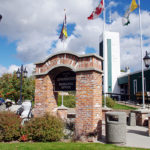Home »

Achieving excellence in high performance home construction
Across British Columbia, builders are learning about the BC Energy Step Code – a provincial regulation that will see the transition of the BC Building Code to net-zero ready by 2032.
Achieving better energy performance in new homes has great benefit for the home-owner, but requires a new approach for the design and build of the homes.
That’s why Bruce Murdoch, owner of K-Country Homes, decided to host a ‘BuildSmart Tailgate’ meeting at a new home he was building as a way to engage his entire construction team. Bruce invited his electricians, framers and plumbers to the event to support them in understanding the role their trades play in protecting the air tightness of a build.

BuildSmart Tailgates are the latest training and engagement strategy developed by the Regional District of the East Kootenay’s (RDEK) community energy manager, Megan Lohmann. Over the past three years, Megan and her team have been working to raise awareness within the East Kootenay building industry around energy performance and the BC Energy Step Code.
The ongoing BuildSmart Tailgate training sessions welcome trades, builders, realtors, building officials, and others to visit a mid-construction air tightness test and immediately identify and address air leaks on-site.
Megan said, “The idea for the Tailgate sessions came directly from the builders themselves. During one of our hands-on building science workshops, builders identified a gap in knowledge of air tightness and the Step Code among the trades and contractors involved in a project. Achieving optimal energy performance requires a collaborative design and build process where everyone understands the goal and their role in ensuring success.”
Bruce Murdoch was the first builder to host a BuildSmart Tailgate Meeting. He commented, “It was great for raising awareness, I would like to have more of my trades attend to understand the importance of maintaining the integrity of the envelope. [The Tailgate] gets them thinking about how they impact the building envelope when they penetrate it.”
The success of this event has led to confirmed funding to support sixteen more free BuildSmart Tailgate Meetings throughout the East Kootenay this year.
The Province of British Columbia has established a timeline for the integration of the BC Energy Step Code into the base code. Starting in 2022, the base building code is expected to require energy modelling and energy performance significantly better than current code. By 2032, net-zero ready construction will be required of all new construction.
Bruce says, “With the Step Code, the greatest effectiveness comes from achieving good air tightness ratings, and, it’s the least expensive thing to do to improve energy performance.”
Several communities in the RDEK are actively preparing their builders to shift to high-performance construction. The RDEK submitted its notification of consultation to the province in March, while three of its member municipalities—Kimberley, Sparwood and Elkford, have already adopted the standard. Additionally, the RDEK is offering incentive funding for builders in electoral areas to integrate energy modelling into their design process.
The building industry in the East Kootenay is remarkably energy literate, leading the province for builders who report that they have built to at least Step 1 of the Step Code.
The shift to net-zero energy ready buildings is well underway across British Columbia, and by adopting a BC Energy Step Code strategy, the RDEK is playing an active role.
If you are a builder interested in hosting a free BuildSmart Tailgate session, contact Gaëtane Carignan, Community Energy Manager at [email protected]
Lead image: Homeowner Cathy Conroy and builder, Bruce Murdoch of K-Country Homes, in front of the home that ultimately achieved an EnerGuide rating of 64 GJ of energy use per year vs 111 GJ on the standard BC Building Code reference house (approximately 57% greater energy efficiency). Photos submitted

Community Energy Association







